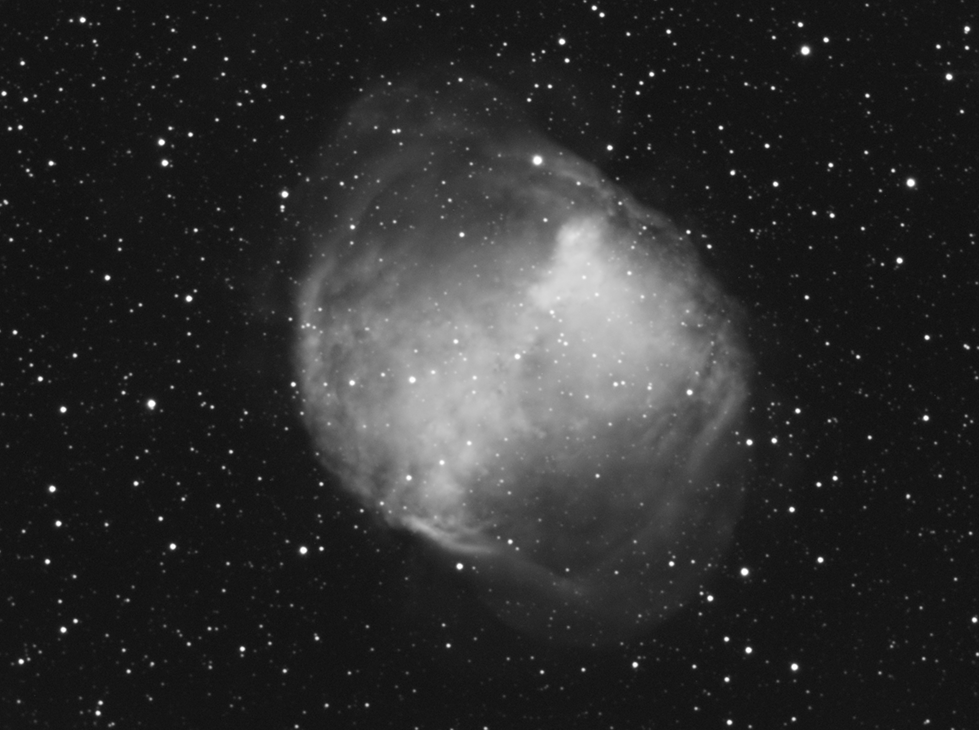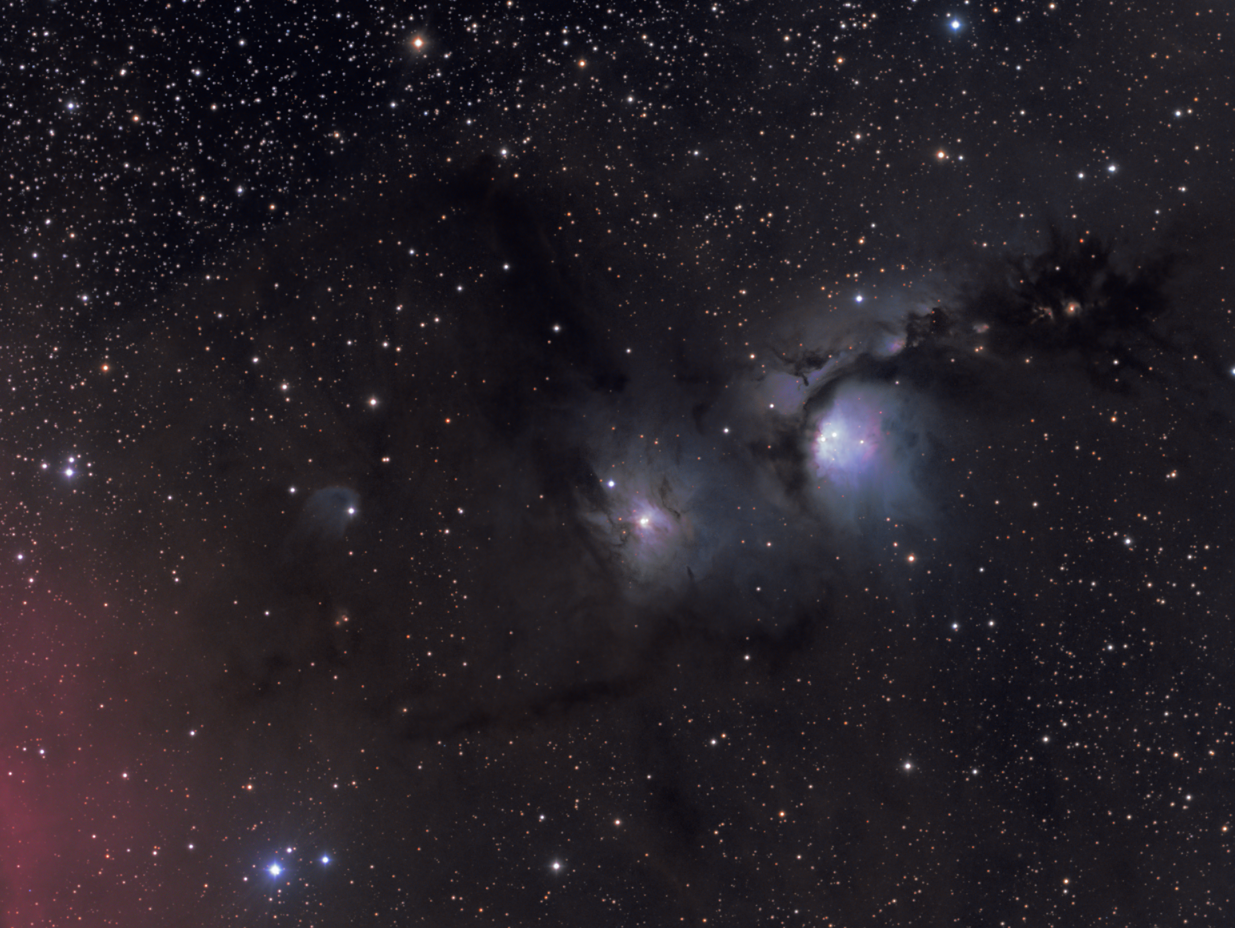November 1, 2016
NGC 604 in M33, Reprise (October 2016)
October 25, 2016
Tadpoles and a Double Star in a Tadpole in IC410 (Oct. 2016)
NGC 604 in M33 (October 2016)
This image is just 12x600" through the CFF290 Classical Cassegrain at f/7.93, with the SXVF-H9 camera.
October 15, 2016
Perseus Galaxy Cluster, at the center (October 2016)
M15 (October 2016)
October 2, 2016
NGC 7006, a Far-out Globular (September 2016)
I have seen this globular in a 4" refractor from very dark skies, and just barely with my 8" f/5 Newtonian from my light-polluted backyard. With no telescope have I resolved any stars in it visually. But here, with the camera, I can resolve many individual stars. This image is just 10x240" through an Astronomik CLS filter and SXVF-H9 camera through the CFF 290 Classical Cassegrain.
Bubble II, NGC 7635 (September 2016)
I made three mistakes in the version published earlier this month: 1) collimation was slightly off and 2) part of my guide camera was loose. These resulted in some slightly non-round stars I fixed as well as I could. This image suffered from none of these. However, this later image was taken on a night when the seeing was not quite as good. Still, it's a lot of fun to see this object at this magnification.
September 22, 2016
Bubble Nebula, NGC 7635 (Sept. 2016)
Ah, had a few nights to image this week. One night was spent re-acquainting myself with the equipment after a four-month interval. Last night was spent recording data. Here is the Bubble, 10x1200" with the SXVF-H9 through the CFF 290 Classical Cassegrain and a 6nm H-alpha filter. The image is shrunken slightly.
May 9, 2016
Mercury Transit (May 9, 2016)
Mercury transiting the Sun, taken with a Canon T3i camera through an Orion 8" f/5 Newtonian telescope with Baader solar filter, May 9, 2016. Plenty of clouds were passing overhead, but now and then I had enough of a chance to catch the planet through them. Nice sunspot group above, too. To see the full image, click here.
May 8, 2016
M57, M27, Palomar 14, NGC 5005, NGC 6210 (May 2016)
Last week we were blessed with three clear nights, and I was able to image on two of them! Here are the results. All were taken with the CFF 290 Classical Cassegrain at f/7.93. The Astro-Physics CCDT67 brings the effective focal length down from f/13.5 to almost exactly 2300mm. The camera is an SXVF-H9, and I shoot through an Astronomik CLS filter. Guiding is done with an OAG and SX Lodestar on a Tak NJP.
M57 is a favorite of mine. I was still up imaging when it rose high enough, so I thought I'd see what I could get. Now I'm excited to image it with a color camera at this focal length. I've never imaged at this focal length, of course. This image is 16x240". M57 is found in Lyra.
M27 is now also on the color list. Nice to see the close up view. This image is 11x360" and is shrunk to 70% of original because the seeing did not warrant the larger size. M27 is found in Vulpecula.
This is Palomar 14, a globular cluster floating well outside of the Milky Way Galaxy. It lies right in the middle of this image. It's brightest stars (one or two) are around magnitude 18, and I can find several in this image that are magnitude >19. Still, I can only count around 15 stars near the center of this image that I believe are cluster members, based on studies I have read. Palomar 14 is notoriously difficult to observe. The bulk of its stars are >22 magnitude. The cluster was discovered in 1958 on photographic plates. This image is just 10x600" and is inverted so that the very dim stars are easier to see. It could use another four hours, perhaps, and a darker location than my backyard. Palomar 14 is found in Hercules.
NGC 5005 is a galaxy in Canes Venatici. I like its grand spiral design, and I find a slight bar in the center, based on measurements of its brighter bulge. It's outer parts are very dim, and I have stretched the image to see them. Several other galaxies can be found in the image. This image is 17x720".
NGC6210 is a planetary nebula in Hercules. The image is just 4x4" + 25x8" = 216 seconds, just over three minutes. The nebula is quite bright. The faintest stars in the image are dimmer than magnitude 15.
M57 is a favorite of mine. I was still up imaging when it rose high enough, so I thought I'd see what I could get. Now I'm excited to image it with a color camera at this focal length. I've never imaged at this focal length, of course. This image is 16x240". M57 is found in Lyra.
M27 is now also on the color list. Nice to see the close up view. This image is 11x360" and is shrunk to 70% of original because the seeing did not warrant the larger size. M27 is found in Vulpecula.
This is Palomar 14, a globular cluster floating well outside of the Milky Way Galaxy. It lies right in the middle of this image. It's brightest stars (one or two) are around magnitude 18, and I can find several in this image that are magnitude >19. Still, I can only count around 15 stars near the center of this image that I believe are cluster members, based on studies I have read. Palomar 14 is notoriously difficult to observe. The bulk of its stars are >22 magnitude. The cluster was discovered in 1958 on photographic plates. This image is just 10x600" and is inverted so that the very dim stars are easier to see. It could use another four hours, perhaps, and a darker location than my backyard. Palomar 14 is found in Hercules.
NGC 5005 is a galaxy in Canes Venatici. I like its grand spiral design, and I find a slight bar in the center, based on measurements of its brighter bulge. It's outer parts are very dim, and I have stretched the image to see them. Several other galaxies can be found in the image. This image is 17x720".
NGC6210 is a planetary nebula in Hercules. The image is just 4x4" + 25x8" = 216 seconds, just over three minutes. The nebula is quite bright. The faintest stars in the image are dimmer than magnitude 15.
April 28, 2016
Best Jupiters Yet, April 2016
This is the best so far. It is 600/3000 frames from Saturday morning, April 23, UT. Taken with the CFF290CC at around f/30, using a TV 2.5x Powermate. Camera is a ZWO ASI224MC. Notice the Great Red Spot on the right.
Below is an image also taken that night but not quite as well. I am learning. But I wanted to catch the moons in action. Here is Io on the right, casting a shadow, and Europa is on the left.
April 17, 2016
Jupiter Through Clouds, ~11:50pm CDT, Friday, April 15, '16; ZWO ASI224MC First Light
This is first light with a new ZWO camera. This image is best 1500 of 3000 frames, taken through the CFF290CC classical Cassegrain at f/13.5. I have not added a magnifier to the imaging train yet, so this is smaller than the images will be when I complete the kit. Also, I was expecting clouds that night and so made other plans, but when I finished what I was doing at 10:30, the sky was clear, so I rushed around and set up. I had not used the camera outside before, but I was excited to see what I could get. By the time I finished setting up, a light layer of clouds had moved over the planet. That prevented really great detail, but I wanted to try out the setup, so here is one 40-second run of several I took. It's very exciting to capture even such detail as this. Jupiter is a fascinating world. The moon on the right is Europa.
April 5, 2016
NGC 4449 (April 2016)
This galaxy is relatively nearby, about 12 million light years away. It is not large as galaxies go, around 20,000 light years across. But it makes a wonderful subject for study. Truthfully, there are Hubble images of it all over, and these are wonderfully processed to show all the activity. Also, the Wikipedia page for it is well done. But here is my humble submission, just 9x720" with an SXVF-H9 and Astronomik CLS filter through the CFF 290mm classical Cassegrain operating at f/7.93. Truthfully, it needs another four hours, but whether I get it or not, this data was really fun to collect. That much detail coming in from 12 million light years away, appearing on my computer screen in my backyard in the middle of the night---very cool.
Adventures with the Classical Cassegrain
We had wonderfully clear weather this last weekend---and no dew! So I was able to try imaging again with the CFF 290 classical Cassegrain. Unfortunately, I chose the first night after a front passed, and seeing was less than optimal; not all of my images worked. I also had no firm goals for the night. I just wanted to do some observing. The bad seeing and thinking about what was working and what wasn't kept me up most of the night. It was a quiet, peaceful night, though, and I was able to obtain images of M51 (10x240"), M63 (15x600") and M13 (95x30"). All images were taken through the Astronomic CLS filter. All have been reduced in size a bit to hide the noise and the effect of less an ideal seeing.
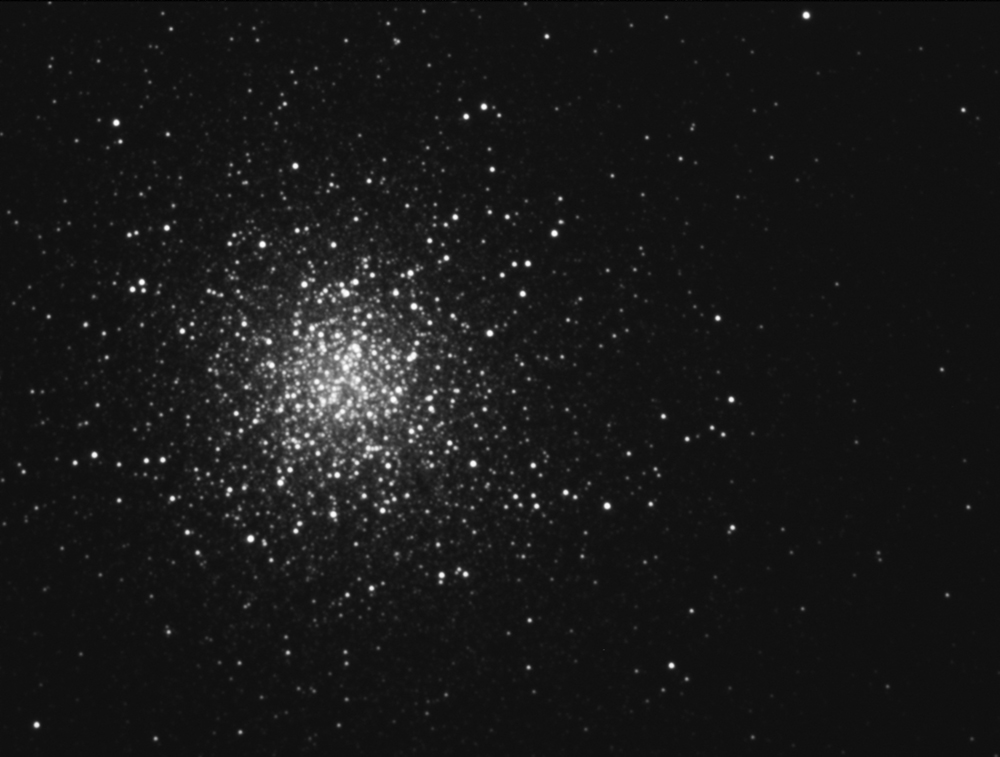
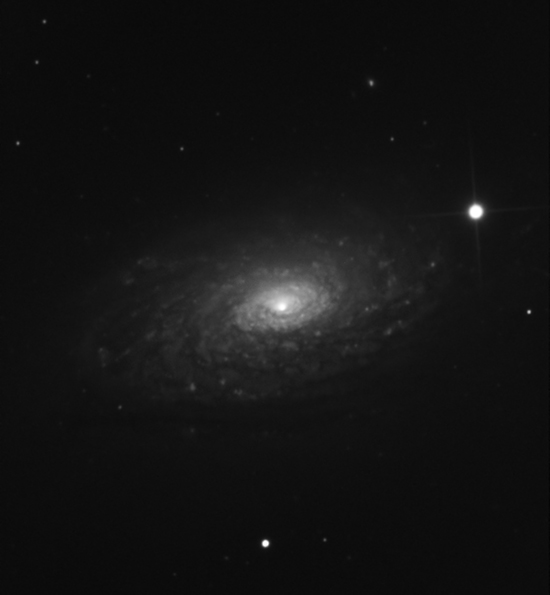
March 13, 2016
M82, M81
Just above and to the left of M82 is a congregation of tiny smudges that constitute a cluster of galaxies. The brightest members are dimmer than 17 magnitude: PGC 2732102 and PGC 2732338.
Scattered throughout the area are clouds of dust in our own galaxy. Galactic cirrus, we call them, but they are relatively local.
The M81-82 group we suspect is about 12 million light years away. The galaxy clusters above and left of M82 may be hundreds of millions of light years away.
This image is 68x900" of Luminance from the dark, dark skies of Deep Sky West. The image has been re-sized to 50% less to handle the blog format.
March 6, 2016
Messier 78 (March 2016)
This bit of nebulosity is called M78, a space in the constellation Orion northeast of the three belt stars and just southwest of the Spook Nebula, LDN 1622. I've always been fascinated by this area. The red nebulosity near the left is emission, but the rest is just reflection from the young, blue-white stars in the area. Of course, new stars are forming here.
This image is a combination of many hours of exposure: 22x900" Luminance; 16x900" Blue; 19x900" Green; 18x900" Red. This is from DSW's FSQ rig. Here is the Luminance stack, with some processing:
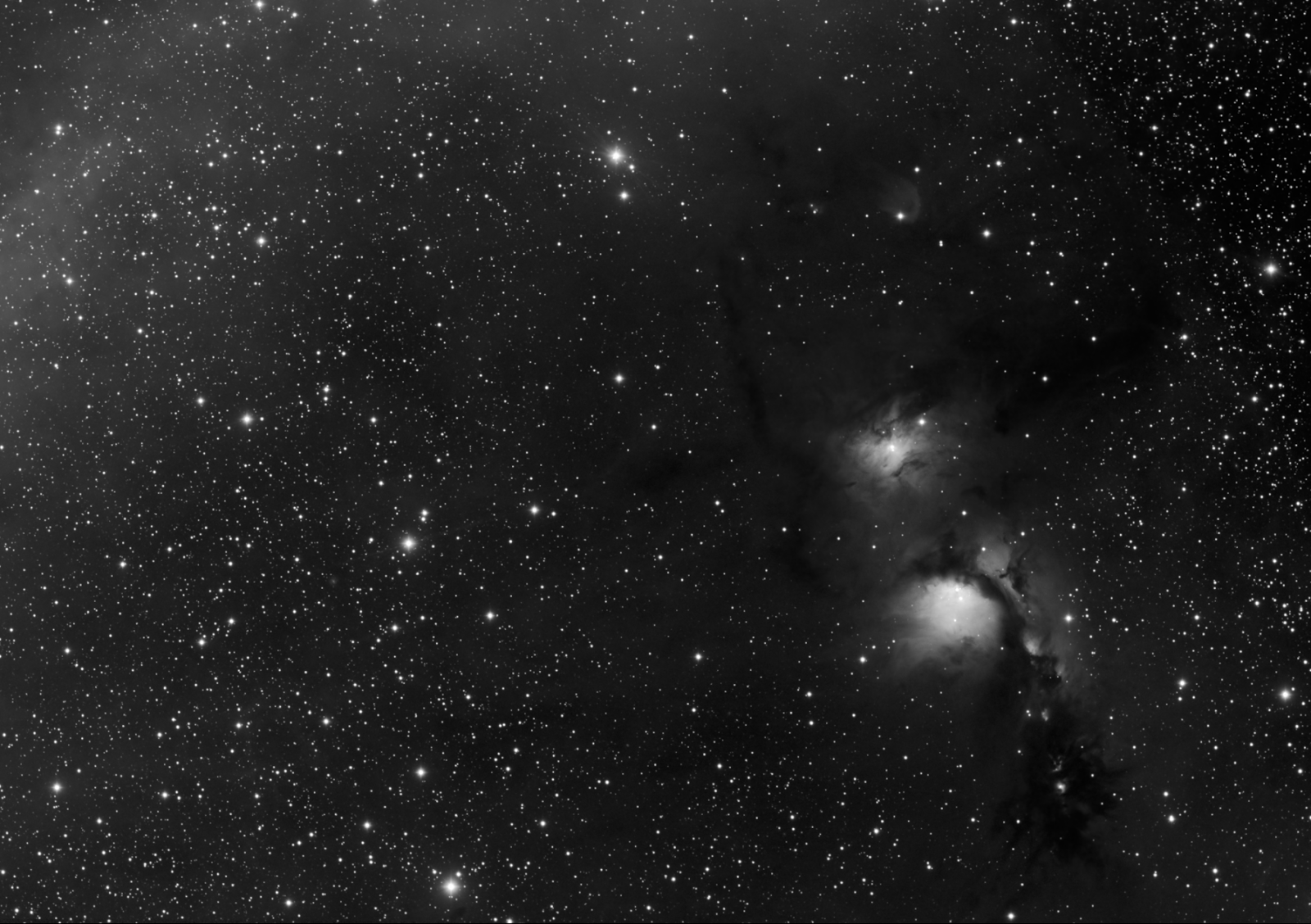
Messier 66 (March 2016)
Here is galaxy Messier 66, in the constellation Leo. The galaxy is close for a galaxy, roughly 32,000,000 light years away. Notice that the galaxy is not symmetrical. It has been pulled, perhaps by nearby galaxy NGC 3628 (which also appears disturbed) or perhaps by M65 (which appears undisturbed). Anyway, these galaxies are close and bright, and I've imaged all three several times, but never at 2300mm focal length, as this is. Even so, seeing was not optimal that night, and I've shrunk the image down about 40% to account for this. It is still a fun image. This is 13x720" with the SXVF-H9 camera through the CC290 telescope, guided on the NJP. (There were two reflection streaks across the left half of the image. I did my best to erase them, but faint signs of them still exist. I'm not sure where they came from, but I am fairly confident they were not in space.)
February 29, 2016
Cone Area in H-Alpha (Feb. 2016)
These images are of the Cone Nebula area. Of course, you can also see the Fox Fur Nebula near NGC2264 (also called the Christmas Tree Cluster), B39 (the darkest nebula near the bottom), and NGC2259 (the star cluster on the lower right). It's a busy area in the Winter Milky Way. The bright star to the left that seems to be in the middle of everything is S Monocerotis, a type O7V star 4x wider than our sun and hundreds of times brighter. See info about S Mon here.
The total time for this image is 9 hours of h-alpha with DSW's FSQ.
February 26, 2016
NGC2419, the Far Away Globular Cluster (Feb. 2016)
The bright star above the cluster is HD60771, a magnitude 7.19 A-type star. There are several small galaxies in the image.
As before, the NJP guided like a champ. Here is a screen shot of PHD2 (with a misleading equipment name, as I missed one of my spacers when I first figured the effective focal ratio):
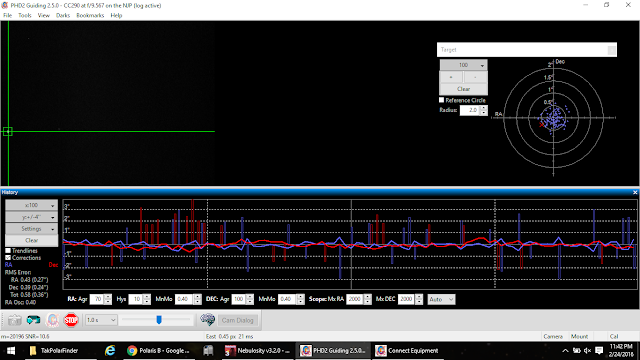
February 25, 2016
LDN 1622 (Feb. 2016)
February 15, 2016
First Light with the CFF Telescopes CC290 f/13.5
This past week I celebrated first light with the CC290, a classical cassegrain built by CFF Telescopes. The scope arrived last week. I've had two great nights of visual viewing and a great night of imaging with it. I hope to write a full review later. Just two comments for now.
First, some notes from the visual. I set the scope out and ran the fans for a while. On the visual nights, the temp was around 41F, so the scope took a bit to cool. Once it cooled down, images were stunning!
One highlight of the first night was IC 418. IC 418's central star was obvious, and the oval ring around the star was obvious, too, at 157x with a 25mm TV Plossl.
The showpiece of the first night was the Trapezium. The E and F stars shown out like searchlights! I've never seen them so bright and clear! Clear, empty space between the F and D stars and between A and E. It was an awesome sight! The nebula was bright, too, and I could begin to see some color in it, mostly green, even from my suburban location.
The second night was just as cold, so the scope took a while to cool off. This night was also first light with a Baader Zeiss 2" prism diagonal. I used several eyepieces. One was a Meade 28mm. This eyepiece yields 140x, an exit pupil of 2.07, and a true field of .486 degrees. For greater magnification, I used the Televue 25mm plossl (very sharp, 157x, 1.85 exit pupil, and 0.318 degree field) and the Orion 15mm expanse (261x, an exit pupil of 1.11, and a true field of 0.261). Here are notes on some objects observed:
NGC 2438 in M46 - a ghostly round glow, gray and uniform as far as I could tell, visible only in the 28mm.
Eskimo Nebula: a bulbous shape and two levels of brightness (inner and outer), central star obvious. Very bright! Nicely studied in the 28mm and the 25mm plossl.
NGC 2371 - I can see two gray lobes clearly. Best in the 28mm.
M65, M66, M96, M95, M105, NGC 2903, NGC 3626 - all good but just faint fuzzies of varying shapes.
NGC 2419 -very dim in the 25mm, not a real showcase.
Sirius B - tougher than I thought it would be in the 15mm, but there is that little star.
A few nights later, the sky was clear, and I set up for imaging. The real test was whether the scope would guide at f/10. I have an Astro-Physics CCDT67 reducer. Set up to reduce at about 0.5873x, the reducer yields round stars across my smaller ccd chip. That gives me an effective focal length of 2299mm. Could the NJP guide at that length? This is an effective focal ratio of f/7.93.
I thought since the Eskimo Nebula was so bright that it would be a good target. I slewed over and, yes, there it was on my computer screen. But . . . no guide star in my off-axis guider. But the nebula was so bright. I decided to catch 300 five-second subs and stack them just for fun, so here's the result.
This is not a real attempt, just fun with the camera and scope. The subs were unguided, and there was some smearing from seeing and perhaps from the mount's movement, though the mount tracks extremely well. Anyway, someday I'd like to go back and get the nebula with narrowband filters.
After that, I slewed to a couple of galaxies in M44, where I knew I would have guide stars. Sure enough, I did, and I tried guiding. I'm still dancing around (metaphorically) from the result! Can this scope guide on the NJP at 2300mm? Absolutely! Actually, seeing was good, and guiding was under one arc second, peak to peak. How's that for fun?!? I took four 500-second images of some very distant galaxies behind M44, then slewed over to NGC 2903 and took a quick five-minute sub. Should I post it? Here it is. It's just a single sub at nearly f/8, and no flats because I did not have time (which explains the donut in the upper right). Contrast is poor, and the image is kind of grainy, but look at the size of that thing.
All kinds of detail in that galaxy. I'm still a bit shocked and thrilled that the scope will guide at that focal length. Ah, this is going to be great! Of course, auto-guiding at that focal length would be impossible if the scope were not extremely well made, very stiff. The scope also handles temperature changes very well. Kudos and thanks to CFF! Here are some images of the scope.
First, some notes from the visual. I set the scope out and ran the fans for a while. On the visual nights, the temp was around 41F, so the scope took a bit to cool. Once it cooled down, images were stunning!
One highlight of the first night was IC 418. IC 418's central star was obvious, and the oval ring around the star was obvious, too, at 157x with a 25mm TV Plossl.
The showpiece of the first night was the Trapezium. The E and F stars shown out like searchlights! I've never seen them so bright and clear! Clear, empty space between the F and D stars and between A and E. It was an awesome sight! The nebula was bright, too, and I could begin to see some color in it, mostly green, even from my suburban location.
The second night was just as cold, so the scope took a while to cool off. This night was also first light with a Baader Zeiss 2" prism diagonal. I used several eyepieces. One was a Meade 28mm. This eyepiece yields 140x, an exit pupil of 2.07, and a true field of .486 degrees. For greater magnification, I used the Televue 25mm plossl (very sharp, 157x, 1.85 exit pupil, and 0.318 degree field) and the Orion 15mm expanse (261x, an exit pupil of 1.11, and a true field of 0.261). Here are notes on some objects observed:
NGC 2438 in M46 - a ghostly round glow, gray and uniform as far as I could tell, visible only in the 28mm.
Eskimo Nebula: a bulbous shape and two levels of brightness (inner and outer), central star obvious. Very bright! Nicely studied in the 28mm and the 25mm plossl.
NGC 2371 - I can see two gray lobes clearly. Best in the 28mm.
M65, M66, M96, M95, M105, NGC 2903, NGC 3626 - all good but just faint fuzzies of varying shapes.
NGC 2419 -very dim in the 25mm, not a real showcase.
Sirius B - tougher than I thought it would be in the 15mm, but there is that little star.
A few nights later, the sky was clear, and I set up for imaging. The real test was whether the scope would guide at f/10. I have an Astro-Physics CCDT67 reducer. Set up to reduce at about 0.5873x, the reducer yields round stars across my smaller ccd chip. That gives me an effective focal length of 2299mm. Could the NJP guide at that length? This is an effective focal ratio of f/7.93.
I thought since the Eskimo Nebula was so bright that it would be a good target. I slewed over and, yes, there it was on my computer screen. But . . . no guide star in my off-axis guider. But the nebula was so bright. I decided to catch 300 five-second subs and stack them just for fun, so here's the result.
This is not a real attempt, just fun with the camera and scope. The subs were unguided, and there was some smearing from seeing and perhaps from the mount's movement, though the mount tracks extremely well. Anyway, someday I'd like to go back and get the nebula with narrowband filters.
After that, I slewed to a couple of galaxies in M44, where I knew I would have guide stars. Sure enough, I did, and I tried guiding. I'm still dancing around (metaphorically) from the result! Can this scope guide on the NJP at 2300mm? Absolutely! Actually, seeing was good, and guiding was under one arc second, peak to peak. How's that for fun?!? I took four 500-second images of some very distant galaxies behind M44, then slewed over to NGC 2903 and took a quick five-minute sub. Should I post it? Here it is. It's just a single sub at nearly f/8, and no flats because I did not have time (which explains the donut in the upper right). Contrast is poor, and the image is kind of grainy, but look at the size of that thing.
All kinds of detail in that galaxy. I'm still a bit shocked and thrilled that the scope will guide at that focal length. Ah, this is going to be great! Of course, auto-guiding at that focal length would be impossible if the scope were not extremely well made, very stiff. The scope also handles temperature changes very well. Kudos and thanks to CFF! Here are some images of the scope.
February 4, 2016
NGC 1333 (Winter 2016)
Distances to the NGC 1333 area---the nebula and cluster---come from two sets of studies. One set holds that the distance is around 760 light years, the other set around 1140 light years.
Just below the nebula are two distinctly redder knots of nebulosity. The upper right one is HH 12, and the lower left one is HH 7-11, meaning there are actually five Herbig-Haro catalog objects here, though we are probably seeing only the outflow from one source, an infrared young stellar object known as SVS 13.
Over on the right, near the top, is HD 21110, enveloped in whitish waves of nebulosity. The star is a type K4 and appears to be passing through the nebulosity, according to this source. The source also suggests that the variability sometimes observed in the star in the past may result from its passing behind dust clouds of varying opacity. Really fascinating.
The bluish star on the center right surrounded by bluish nebulosity is SAO 56444 of BD +30°540. It is type B8V, which explains the blue reflection nebula around it.
This image is a combination LRGB 28:16:16:16 x 900" with the FSQ setup at DSW.
January 18, 2016
"Big Headless Running Giant" Nebula (Jan. 2016)
This is first light for an Orion 203mm f/4.9 Newtonian I just bought. It's not an expensive scope, and it obviously has some diffraction problems. I trace most of the problems to the mirror clips and the bevel around the mirror, which needs to be blackened or covered. A mirror retaining ring would do the trick nicely. I did attach a FT focuser, electronically controlled. But the scope held collimation and imaged around the sky for five hours with up to 7-minute exposure without a hitch. Seems to be enough to work with here.
This image is 39x180" with the SXVF-H9C. I used the Baader MPCC flattener, which magnifies 1.15x, so this focal length is effectively 1150mm. The image was shrunk to 67% to hide some noise and the funny star shapes caused by the diffraction and perhaps by a mirror that had not settled into the temperature early in the imaging run.
January 13, 2016
Sole Nebula (Collinder 34 and IC 1848) (Fall 2015)
Collinder 34 is on the left. The nebula around it is lit up in large part by the cluster's type-O star HD 18326. Source. The source notes that Collinder 34 and 32 are parts of Collinder 33—three clusters appearing around and on top of each other, so if the cluster is hard to pick out, no surprise. On the left, trace the direction of the source of radiation back to the type-O star. However, there are several O- and B-type stars throughout this area, and they all surely contribute to the glow.
IC 1848 appears to be the name for both the cluster on the right as well as the whole nebular complex. The cluster on the right contains the two type-O stars HD 17520 and HD 17505, which play a leading role.
This image is an HaRGB, combining 18x1800" of Ha with 16:16:16 x 900" RGB through Deep Sky West's FSQ.
I frankly am baffled why this complex is sometimes called the "soul nebula," though I have some ideas. Nearby is IC 1805, which is shaped like a heart. "Heart and soul" seem to go together better than "heart and sole." But no nebula looks like a soul. This complex does look like a sole, however; doesn't it remind you vaguely of a footprint? The complex is sometimes called the fetus nebula because of its shape. A fetus is a soul, but so is a full-grown human being, so that cannot be it. I conclude that wishful emotionalism and poor spelling created the misnomer.
Here is a close-up of the most intricate part of the nebula, at full resolution for the FSQ setup.
And here is a large-size Ha frame.
Subscribe to:
Comments (Atom)










